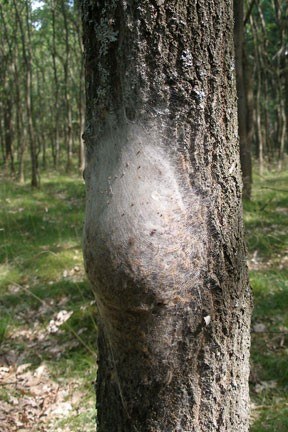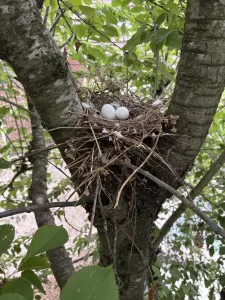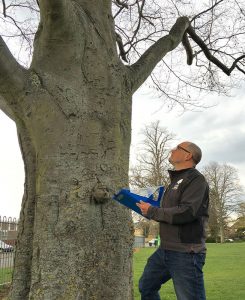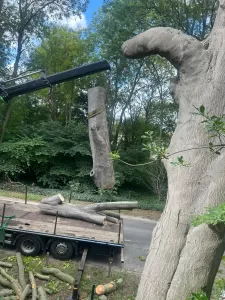If you’ve spotted our teams at work around an Oak Processionary Moth nest this information will help you learn more about why we are there and what we are doing.
Oak Processionary Moths are pests of oak trees, and a hazard to human and animal health. These furry little fiends feast upon the oak leaves in large quantities and heavy infestations can completely defoliate the trees, leaving them weak and vulnerable. Stripping the trees bare of leaves is not the only problem – the hairs are the caterpillars main defence mechanism and coming into contact with them can cause skin and eye irritations, sore throats and breathing difficulties in people and animals.
What is the OPM?
OPM is the common term for the Oak Processionary Moth (Thaumetopoea processionea). They were thought to have been accidentally brought over from imported trees from continental Europe in 2005. It was first confirmed in Richmond in 2006. This led to an investigation by the Environmental Health Service. Worryingly, it is spreading in all directions rapidly and now inhabits all boroughs of London and the adjoining counties.
OPM eat almost exclusively Oak leaves and spin spiderweb like nests to protect themselves in large groups. These can range in size and be as big as a rugby ball. They can be found at ground level as well as in anywhere in the main canopy.
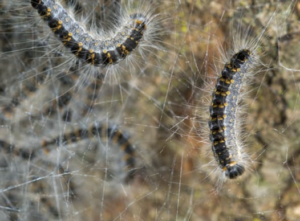
When migrating from the nest to the feeding grounds the caterpillars travel in a chain nose to tail giving rise to the name Oak Processionary Moth.
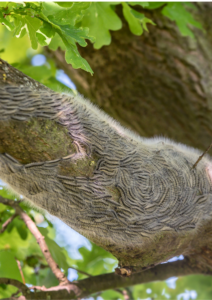
How can you identify their nests?
Their nests look like silken sacks that may more commonly be associated with spiders, and range in size from a golf ball to a rugby ball. These nests can be found on the main trunk and underside of structural limbs, where-as the caterpillar itself will be found travelling in convoy (hence the name processionary) to the leaves or within the leaf canopy. There can be many nests within one tree. It is also important to note that the nests can be very low down, near the ground so can be problematic for children and pets. Nests must be removed by trained professionals using specialist equipment, to ensure the safety of all concerned.
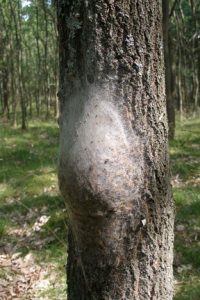
What’s the problem with OPM?
There are health risks when we come in to contact with OPM or more specifically their hairs, also known as urticating hairs, that protect the caterpillars from predation.
Each individual hair, and there can be hundreds of thousands on each caterpillar, are tipped with a sharp barb loaded with a protein called Thaumetopoiene which acts as a toxin when introduced to the body. The hairs can remain active for many years even after they have been shed from the host.
The most common complaint from contact with the OPM hairs are a rash or blisters on the skin which can be very uncomfortable for several days, or even months, after contact. The problems can be a lot worse if the hairs get in to the eye or throat. Other less common symptoms that have been reported are fever, dizziness and vomiting.
Why can’t we control the spread?
This species has been particularly difficult to control due to a number of factors. In fact, Holland have been trying to eradicate OPM for 30 years without success.
- The frequency that the eggs hatch. Eggs will typically be laid from July To September. In rows a single egg deep with a distinct scale appearance. This can have a significant number of eggs, up to 300, in a plaque formation. Some, but not necessarily all the eggs, will hatch the following spring. It is the eggs that decide not to hatch from the same plaque, in the same year, that make it difficult to target with eradication methods such as insecticide spraying.
- There are currently no insecticides that only target OPM. This means that treatment of large woodland areas rich in Oak trees would also decimate the other native species so vital to our eco system. This is something we cannot do and means that populations are allowed to survive in order to protect others.
- This a relatively new invader and is still is relatively unknown, even within the arboricultural industry outside of London, let alone the private tree owners. This would suggest that populations of OPM are either misdiagnosed or missed completely.
What are the control methods available?
Identified nests can be removed by trained personnel under highly controlled conditions. Given the serious nature of coming into contact with OPM hairs specialist protective clothing is worn to safely remove the nests.
What should you do if you find a nest?
The Forestry Commission recommends the following health precautions:
DO NOT:
• touch or go near to the nests or caterpillars;
• let children touch or go near to nests or caterpillars;
• let animals touch or go near to nests or caterpillars;
• attempt to remove the nests or caterpillars yourself.
DO:
• teach children not to touch or approach the nests or caterpillars;
• be vigilant and train or restrain pets from touching or approaching them;
• keep horses and livestock a safe distance from infested oak trees. If needed, covering or stabling livestock can help;
• visit a pharmacist for relief from skin or eye irritations if you suspect OPM contact;
• call NHS111 or visit a doctor if you suspect you or someone in your care has had a serious allergic reaction;
• speak to a vet if you think your pet or livestock is affected;
• contact an expert to remove infestations in your own trees;
• report any sightings to The Forestry Commission
If you suspect you have seen some OPM, ensure you follow the precautions above. We have trained professionals on our team here at The Blue Tree Company who can safely remove nests. Please contact us on 01462 450203 or email info@thebluetreecompany.com

